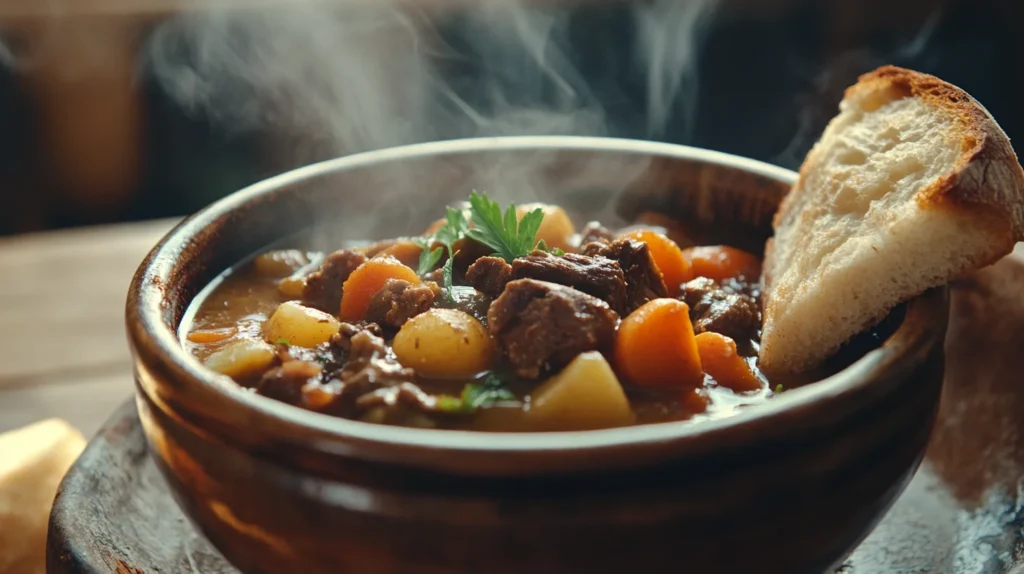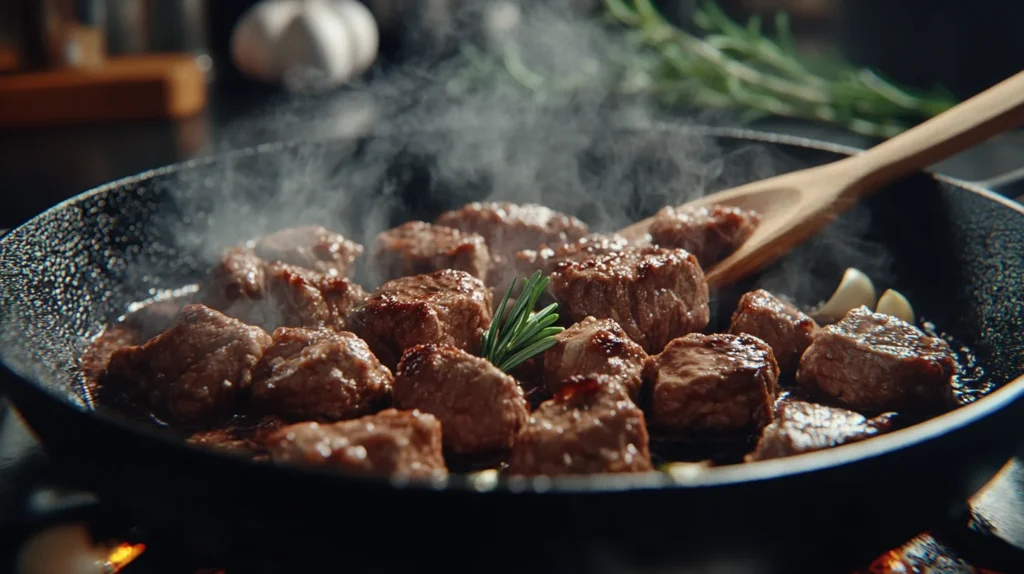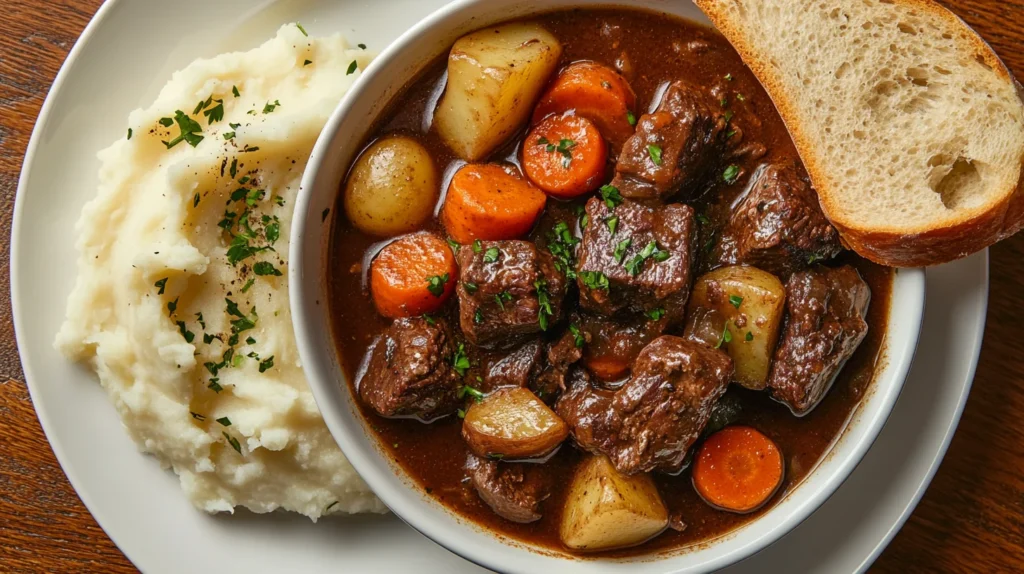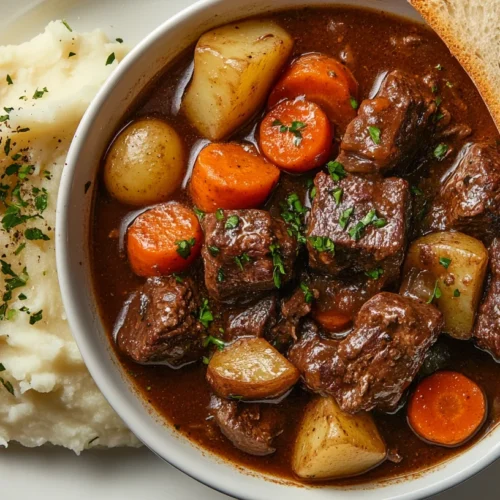Beef stew is the ultimate comfort food, rich in flavor and packed with tender meat and hearty vegetables. Whether you’re making it on a cold winter evening or preparing a wholesome meal for your family, a crockpot beef stew is one of the easiest and most delicious dishes to make.
Using a slow cooker, you can achieve a deep, rich taste with minimal effort. Simply toss in your ingredients, set the temperature, and let the crockpot work its magic. The result? A melt-in-your-mouth stew with bold flavors, tender beef, and a thick, savory broth.
In this article, we’ll cover everything you need to know about making the best beef stew in a crockpot. From choosing the right ingredients and cooking times to expert tips and variations, you’ll have all the information needed to create a perfect slow-cooked stew.

Why Use a Crockpot for Beef Stew?
Beef stew is a dish that benefits greatly from slow cooking, and a crockpot is the perfect tool for the job. Unlike stovetop cooking, which requires frequent stirring and attention, a slow cooker allows you to set your ingredients and forget about them until it’s time to eat.
The Benefits of Slow Cooking
Using a crockpot for beef stew offers several key advantages:
- Enhanced Flavor Development – Slow cooking allows flavors to blend and deepen over time, creating a rich, well-balanced taste.
- Tender Meat – Tough cuts of beef break down gradually, resulting in buttery, melt-in-your-mouth meat.
- Effortless Cooking – With just a few minutes of prep, you can let the slow cooker handle the rest, making it perfect for busy schedules.
- One-Pot Convenience – Everything cooks in the same pot, reducing cleanup time.
- Energy Efficient – Crockpots use less energy compared to traditional stovetop or oven cooking.
How a Crockpot Enhances Flavor and Texture
One of the best parts of cooking beef stew in a slow cooker is the way it transforms tough cuts of meat into tender, juicy perfection. This is because slow, low-temperature cooking breaks down connective tissue in meats like chuck roast, brisket, and round steak, making them fork-tender without drying out.
Additionally, vegetables like carrots, potatoes, and onions absorb the savory broth over several hours, creating a deep, umami-packed flavor. The slow cooking process ensures that the vegetables remain firm yet tender, rather than turning mushy.
Time-Saving and Convenience Factors
If you’re someone who prefers minimal hands-on cooking, the crockpot is your best friend. Here’s why:
- You can prepare ingredients the night before, store them in the fridge, and simply transfer everything to the slow cooker in the morning.
- There’s no need for constant stirring or checking – just let the slow cooker do the work.
- You can leave it unattended while at work or running errands, knowing that dinner will be ready when you return home.
Why Crockpot Beef Stew is Perfect for Meal Prep
Another advantage of slow cooker beef stew is that it makes for excellent leftovers. The flavors continue to develop even after cooking, making the dish tastier the next day. Plus, it stores and reheats well, making it ideal for batch cooking and meal prep.
Choosing the Right Ingredients for the Best Beef Stew
To make a delicious and hearty crockpot beef stew, selecting the right ingredients is key. From the cut of beef to the vegetables and seasonings, each component plays a vital role in building deep flavors and a rich texture.
Best Cuts of Beef for Slow Cooking
The best options are tougher cuts with a good amount of marbling and connective tissue, as they break down beautifully over hours of slow cooking, becoming juicy and tender.
Here are the top choices:
- Chuck Roast – The most popular cut for beef stew. It has plenty of marbling, which makes it incredibly flavorful and tender when slow-cooked.
- Brisket – A fattier cut that delivers deep flavor but takes longer to tenderize.
- Round Roast (Bottom Round or Top Round) – Leaner than chuck but still a great option when cooked low and slow.
- Short Ribs (Boneless or Bone-In) – Adds an extra richness to the stew, thanks to the bones and fat content.
💡 Pro Tip: Avoid using lean cuts like sirloin or filet mignon, as they lack the fat needed to stay moist during slow cooking and can become dry.
Essential Vegetables for a Balanced Flavor
Vegetables add both flavor and texture to beef stew. Here are the must-have ingredients:
- Carrots – Naturally sweet and slightly firm, carrots hold up well in the slow cooker.
- Potatoes – Yukon gold or red potatoes are best because they stay firm and creamy. Avoid russet potatoes, as they tend to fall apart.
- Onions – Adds sweetness and depth to the broth. Yellow onions are ideal, but red or white onions work too.
- Celery – Enhances the broth with a mild aromatic flavor.
- Garlic – A must-have ingredient for a rich, savory stew.
💡 Optional Add-Ins for Extra Depth:
- Mushrooms – Provide an earthy, umami flavor.
- Parsnips – A great alternative or addition to carrots, adding a mild sweetness.
- Sweet Potatoes – A slightly sweeter twist on traditional beef stew.
Broths, Seasonings, and Herbs to Enhance Taste
A flavorful broth is essential for a perfect stew. Here’s what you’ll need:
Liquids for the Base:
- Beef Broth (or Stock) – The backbone of a good beef stew. Use low-sodium broth to control the saltiness.
- Tomato Paste – Adds depth, umami, and a touch of sweetness.
- Red Wine (Optional) – Enhances richness and balances acidity. If avoiding alcohol, substitute with extra broth or balsamic vinegar.
- Worcestershire Sauce – Brings a deep, umami flavor to the stew.
Best Herbs and Spices for a Rich Stew:
- Bay Leaves – Infuses the broth with a subtle, herbal note.
- Thyme – Works wonderfully with beef and gives the stew an aromatic lift.
- Rosemary – Adds an earthy, pine-like flavor.
- Paprika – A hint of smokiness enhances the broth.
- Black Pepper & Salt – Essential for seasoning. Adjust according to taste.
💡 Pro Tip: Fresh herbs give the stew a more vibrant flavor, but dried herbs work well too.
Secret Ingredients for a Next-Level Beef Stew
Want to take your crockpot beef stew to the next level? Here are a few secret ingredients to consider:
- Soy Sauce or Fish Sauce – Adds a savory umami punch without overpowering.
- Balsamic Vinegar – Brightens up the flavors and balances richness.
- Honey or Brown Sugar – A touch of sweetness enhances the overall taste.
- Dark Chocolate or Cocoa Powder – Sounds unusual, but a tiny amount adds incredible depth to the stew.
By choosing the right ingredients, you can create a rich, flavorful, and comforting beef stew that tastes even better the next day.
Step-by-Step Guide to Making Crockpot Beef Stew
Making crockpot beef stew is incredibly simple, but following a few key steps will ensure you get the best flavor and texture. Here’s a step-by-step guide to achieving a perfectly thick, rich, and savory stew.

Preparing the Ingredients
Before adding everything to the slow cooker, it’s important to properly prepare your ingredients:
- Cut the Beef into Chunks – Trim excess fat and cut the beef into 1.5-inch cubes for even cooking.
- Chop the Vegetables – Dice the onions, celery, and carrots into bite-sized pieces. If using potatoes, cut them into larger chunks so they don’t get too soft.
- Mince the Garlic – Fresh garlic enhances the depth of flavor in the stew.
- Measure the Seasonings – Having spices and herbs ready will make cooking smoother.
💡 Pro Tip: If you want a thicker stew, coat the beef cubes in flour or cornstarch before browning them. This will help create a rich, velvety broth.
The Best Way to Brown the Beef for Extra Flavor
While it’s tempting to throw everything into the crockpot at once, taking a few extra minutes to sear the beef first makes a big difference.
Why Sear the Beef?
Browning the meat creates a deep, caramelized flavor, which enhances the overall taste of the stew. It also locks in juices, ensuring the beef stays tender and moist.
How to Sear the Beef Properly:
- Heat a large skillet over medium-high heat.
- Add a tablespoon of oil (olive oil or butter).
- Sear the beef cubes in batches – Avoid overcrowding the pan so each piece gets a nice crust.
- Cook for 2-3 minutes per side, until browned.
- Transfer the seared beef to the slow cooker.
💡 Pro Tip: Don’t discard the brown bits left in the pan! Deglaze the skillet with a splash of red wine or beef broth, then pour this into the crockpot for extra flavor.
Layering Ingredients in the Slow Cooker
For best results, layer your ingredients in the right order to ensure even cooking:
- Root Vegetables First – Place potatoes and carrots at the bottom since they take the longest to cook.
- Meat in the Middle – Add the seared beef on top of the vegetables.
- Aromatics on Top – Layer the onions, garlic, and celery next.
- Liquids and Seasonings Last – Pour in beef broth, Worcestershire sauce, tomato paste, and seasonings. Stir slightly to mix the flavors.
💡 Pro Tip: Avoid stirring too much at the beginning—this helps the meat and veggies cook properly in their layers.
Setting the Right Cooking Temperature and Time
Slow cooking is all about patience. The best results come from cooking low and slow:
- Low Setting (8-10 Hours) – The best option for achieving fork-tender beef and well-developed flavors.
- High Setting (4-6 Hours) – Works if you’re short on time, but the meat won’t be quite as tender.
💡 Pro Tip: If possible, cook on low for at least 8 hours—this allows the collagen in the beef to break down, making it extra juicy and soft.
Adding Finishing Touches
After hours of slow cooking, your beef stew will be nearly perfect. Here are the final steps:
- Check Consistency – If the stew is too thin, mix 1 tablespoon of cornstarch with 2 tablespoons of water and stir it in. Cook for another 20-30 minutes to thicken.
- Taste and Adjust Seasoning – Add salt, pepper, or a splash of Worcestershire sauce if needed.
- Add Fresh Herbs – Toss in some fresh parsley or thyme for a fresh, aromatic finish.
💡 Pro Tip: Let the stew sit for 10-15 minutes before serving—this allows the flavors to meld together for the best taste.
Tips for a Flavorful and Perfectly Cooked Beef Stew
A great crockpot beef stew isn’t just about following a recipe—it’s about knowing the little tricks that make all the difference. Here are some expert tips to ensure your stew is thick, flavorful, and perfectly cooked.
How to Thicken the Stew Properly
If your stew is too thin after slow cooking, there are a few ways to thicken it:
- Cornstarch Slurry – Mix 1 tablespoon cornstarch with 2 tablespoons cold water, stir it in, and let the stew cook for another 20-30 minutes.
- Flour Slurry – Similar to cornstarch, but using flour instead. Whisk 1 tablespoon flour with 3 tablespoons water before adding.
- Mashed Potatoes – Remove a few soft potatoes from the stew, mash them, and stir them back in to naturally thicken the broth.
- Bread Crumbs or Roux – A small piece of stale bread or a roux (butter + flour cooked together) can also help thicken the broth.
💡 Pro Tip: Avoid adding flour or cornstarch directly into the stew without mixing with water first—it will clump up.
Best Herbs and Spices for Depth of Flavor
Seasoning is key to a delicious stew.
- Bay Leaves – Adds a subtle earthy aroma.
- Thyme – Works well with beef for a rich, herbaceous flavor.
- Rosemary – A slightly piney taste that pairs beautifully with slow-cooked beef.
- Paprika – Smoked paprika adds a warm depth to the broth.
- Cumin & Coriander (Optional) – A small amount adds an extra layer of warmth.
- Black Pepper & Salt – Always adjust to taste near the end of cooking.
💡 Pro Tip: Fresh herbs should be added at the end of cooking, while dried herbs should go in at the beginning for the best flavor infusion.
Adjusting Seasoning for Different Taste Preferences
Not everyone likes their stew the same way. Here’s how to tweak it:
- For a richer flavor: Add a splash of red wine or balsamic vinegar.
- For a smoky depth: Stir in a teaspoon of smoked paprika.
- For extra umami: Add a dash of soy sauce or Worcestershire sauce.
- For a touch of sweetness: Try a teaspoon of brown sugar or honey.
- For a bit of heat: Add a pinch of red pepper flakes or cayenne pepper.
💡 Pro Tip: If your stew tastes flat, add a bit of acidity—a few drops of lemon juice or vinegar can bring out the flavors.
Variations of Crockpot Beef Stew
While the classic beef stew is delicious on its own, you can easily customize it based on dietary preferences or personal taste. Here are some fun variations to try:
Classic vs. Modern Twists on the Recipe
- Traditional Beef Stew – Uses beef, potatoes, carrots, and onions with a rich broth made from beef stock and tomato paste.
- French-Style Beef Stew (Boeuf Bourguignon) – Includes red wine, pearl onions, mushrooms, and bacon for a gourmet twist.
- Italian-Inspired Stew – Features tomato-based broth, Italian herbs, and cannellini beans for a Mediterranean flair.
- Spicy Mexican Stew – Uses chipotle peppers, cumin, black beans, and corn for a Tex-Mex feel.
- Asian-Inspired Stew – Infused with soy sauce, ginger, and star anise, served over rice instead of potatoes.
💡 Pro Tip: Switching up herbs and spices can transform your stew into a whole new dish!
Keto and Low-Carb Versions
For a low-carb or keto-friendly version, swap out high-carb ingredients with these alternatives:
- Replace Potatoes with: Cauliflower, turnips, or rutabaga.
- Use a Thickening Alternative: Instead of flour or cornstarch, try xanthan gum or let the broth naturally reduce.
- Add More Protein: Toss in extra beef or low-carb vegetables like bell peppers and zucchini.
💡 Pro Tip: Avoid adding starchy vegetables like carrots in large amounts if you’re on a strict keto diet.
Adding Red Wine or Tomato Paste for Richness
For a deeper, more complex broth, consider:
- Red Wine: Adds acidity and richness—perfect for French-style stews.
- Tomato Paste: Provides a sweet, umami boost and helps thicken the broth.
- Balsamic Vinegar: A splash at the end brightens up the dish.
💡 Pro Tip: If using wine, opt for a dry red wine like Cabernet Sauvignon or Merlot for the best depth of flavor.
Alternative Protein Options (Chicken, Lamb, or Plant-Based)
Want to try something different? Swap the beef for:
- Chicken (Bone-in Thighs or Breasts) – Cooks faster but still becomes tender.
- Lamb (Shoulder or Leg Chunks) – Adds a rich, gamey flavor, especially with rosemary and garlic.
- Plant-Based Protein (Lentils, Chickpeas, or Tofu) – Makes a vegetarian-friendly stew with all the same flavors.
💡 Pro Tip: If using chicken, reduce the cooking time to 4-6 hours on low to prevent overcooking.
What to Serve with Beef Stew
A hearty crockpot beef stew is a complete meal on its own, but pairing it with the right sides and beverages can elevate the experience. Here are the best accompaniments for a cozy and satisfying meal.

The Best Bread and Side Dishes
- Crusty Bread – A loaf of French baguette, sourdough, or homemade bread is perfect for soaking up the flavorful broth.
- Buttery Biscuits – Soft, flaky biscuits add a delicious texture contrast.
- Mashed Potatoes – If you skip potatoes in the stew, serve it over creamy mashed potatoes for extra comfort.
- Rice or Quinoa – A great gluten-free alternative to bread.
- Egg Noodles or Pasta – Similar to Hungarian goulash, serving beef stew over buttered noodles makes it heartier.
- Roasted Vegetables – Brussels sprouts, green beans, or asparagus complement the rich, meaty broth.
💡 Pro Tip: To keep things light, serve stew with a simple green salad with balsamic dressing.
Pairing with Wine or Other Beverages
- Red Wine:
- Cabernet Sauvignon – Bold and full-bodied, it enhances the beef’s richness.
- Merlot – A smoother option that pairs well with the stew’s savory flavors.
- Zinfandel – A slightly fruitier wine that complements tomato-based broths.
- Beer:
- Dark Stout or Porter – Rich, malty beers pair beautifully with slow-cooked beef.
- Amber Ale – A balanced beer that doesn’t overpower the dish.
- Non-Alcoholic Options:
- Hot Tea (Black or Herbal) – Adds warmth and a comforting touch.
- Sparkling Water with Lemon – A refreshing contrast to the richness of the stew.
💡 Pro Tip: If using wine in the stew, serve the same wine alongside it for a well-matched flavor experience.
Storing and Reheating Crockpot Beef Stew
One of the best things about crockpot beef stew is that it tastes even better the next day as the flavors continue to develop. Here’s how to properly store and reheat leftovers for the best results.
How to Properly Store Leftovers
To ensure your beef stew stays fresh, follow these storage tips:
- Cool the Stew First – Allow the stew to cool to room temperature before storing it to prevent condensation and bacterial growth.
- Use Airtight Containers – Store stew in glass or plastic containers with a tight-sealing lid to maintain freshness.
- Separate Portions for Convenience – If meal prepping, divide the stew into individual portions before storing.
How Long Does Beef Stew Last in the Fridge?
- 3 to 4 days in an airtight container.
💡 Pro Tip: To extend freshness, consider vacuum-sealing or using a storage bag with excess air removed.
The Best Way to Reheat for Maintaining Texture
When reheating beef stew, avoid overheating, as this can make the meat and vegetables mushy. Here are the best reheating methods:
1. Stovetop (Best for Flavor and Texture)
- Pour the stew into a pot over low to medium heat.
- Stir occasionally until heated through (10-15 minutes).
- If the broth has thickened, add a splash of beef broth or water to loosen it.
2. Microwave (For Quick Reheating)
- Place a portion in a microwave-safe bowl.
- Cover loosely with a lid to prevent splattering.
- Heat on 50-70% power in 1-minute intervals, stirring in between to ensure even heating.
3. Slow Cooker (For Large Batches)
- Set the crockpot to low heat and reheat for 1-2 hours, stirring occasionally.
💡 Pro Tip: Add a small amount of butter or fresh herbs when reheating to refresh the flavors.
Can You Freeze Beef Stew? Tips for Best Results
Yes! Beef stew freezes very well, making it perfect for meal prep.
How to Freeze Beef Stew Properly:
- Cool the stew completely before freezing.
- Use freezer-safe containers or heavy-duty resealable bags.
- Leave space at the top (about an inch) to allow for expansion.
How Long Does Beef Stew Last in the Freezer?
- Up to 3 months for the best flavor.
💡 Pro Tip: If freezing stew with potatoes, they might become mushy when thawed. Consider removing them before freezing and adding fresh potatoes when reheating.
How to Thaw and Reheat Frozen Beef Stew
- Overnight in the fridge: The safest method—allow at least 8 hours to thaw.
- Quick thaw method: Place the frozen container in a bowl of cold water for a few hours before reheating.
- Direct reheating from frozen: Add the frozen stew to a slow cooker on low heat or a stovetop on medium heat, stirring occasionally.
💡 Pro Tip: Freezing in individual portions makes reheating faster and easier.
Common Mistakes to Avoid When Making Crockpot Beef Stew
Even though crockpot beef stew is a simple dish, a few common mistakes can affect the texture and flavor. Avoid these pitfalls to make the perfect slow-cooked stew every time.
1. Overcooking or Undercooking the Meat
- Overcooking: If left too long (especially on the high setting), the beef can become dry and stringy instead of tender.
- Undercooking: If not cooked long enough, tough cuts like chuck won’t fully break down, leaving you with chewy meat.
💡 How to Fix It:
- Always cook on low for 8-10 hours for the best results.
- If the meat is tough after cooking, let it simmer longer (another 1-2 hours).
2. Adding All Ingredients at the Same Time
Some ingredients cook faster than others. Adding everything at once can lead to:
- Mushy vegetables (like potatoes and carrots).
- Overly soft beef that loses its texture.
💡 How to Fix It:
- Add root vegetables at the beginning since they take longer to soften.
- Add delicate veggies (like peas or spinach) in the last 30 minutes.
3. Not Browning the Meat First
Skipping this step results in less depth of flavor. While it’s not required, searing the beef first:
- Creates a caramelized crust that enhances the broth.
- Helps lock in juices and moisture.
💡 How to Fix It:
- Quickly brown the beef in a skillet with oil for 2-3 minutes per side before adding it to the crockpot.
4. Using Too Much Liquid
Unlike stovetop cooking, slow cookers don’t allow moisture to evaporate, which can make the stew too watery.
💡 How to Fix It:
- Use just enough broth to cover the ingredients (about 3-4 cups).
- If your stew turns out thin, thicken it with a cornstarch slurry or remove the lid in the last 30 minutes to let excess moisture evaporate.
5. Not Seasoning Properly
- If you don’t season early, the flavors can be bland.
- If you add too much salt at the start, the flavors may become overpowering.
💡 How to Fix It:
- Season lightly at the beginning, then adjust before serving.
- Add a dash of Worcestershire sauce, balsamic vinegar, or fresh herbs at the end for a final flavor boost.
Related Reads:
Frequently Asked Questions (FAQs)
What is the secret to good beef stew?
The secret to a great beef stew lies in slow cooking, quality ingredients, and layering flavors. Here are key factors that make a stew exceptional:
- Use the right cut of beef – Chuck roast is the best choice for tenderness and flavor.
- Brown the meat first – Searing beef before adding it to the slow cooker enhances depth and richness.
- Layer ingredients properly – Place root vegetables at the bottom, meat in the middle, and broth last.
- Slow cook on low – Cooking on low heat for 8-10 hours allows the beef to become fork-tender.
- Season in stages – Add herbs and spices early, then adjust seasoning at the end for balanced flavors.
- Thicken the broth – Use a cornstarch slurry or mashed potatoes for a rich, hearty consistency.
How long does beef stew take in a slow cooker?
Beef stew typically takes:
- Low setting: 8-10 hours (best for tender, flavorful results).
- High setting: 4-6 hours (quicker but may result in slightly tougher beef).
For optimal tenderness, it’s best to cook on low for at least 8 hours to allow the collagen in the beef to break down properly.
Can I put raw beef straight into a slow cooker?
Yes, you can put raw beef directly into the slow cooker, but browning it first is highly recommended for better flavor and texture.
Why Brown the Beef First?
- Creates a deep, rich flavor by caramelizing the surface.
- Locks in juices, preventing the meat from drying out.
- Adds umami depth to the broth.
💡 If you’re short on time, you can skip browning, but your stew may have a milder flavor.
Is it better to cook stew on low or high in a slow cooker?
Cooking on LOW is best for beef stew because it allows the meat to break down slowly, resulting in tender, juicy beef and well-developed flavors.
- Low (8-10 hours) → Best choice for soft, flavorful beef.
- High (4-6 hours) → Works if you’re short on time, but the beef may be slightly tougher.
💡 Pro Tip: If you have time, always choose the low setting for the most flavorful and tender beef stew.
Conclusion
A crockpot beef stew is the ultimate comfort food—rich, hearty, and packed with tender beef and flavorful vegetables. By following the right steps, choosing the best ingredients, and avoiding common mistakes, you can create a delicious, foolproof stew every time.
Key Takeaways for the Perfect Beef Stew:
Use the right cut of beef – Chuck roast is the best choice for tenderness.
Brown the meat first for deep, caramelized flavor.
Layer ingredients properly – Root vegetables at the bottom, meat in the middle, and liquids last.
Slow cook on LOW for 8-10 hours for the best texture.
Thicken properly using a cornstarch slurry, flour, or mashed potatoes.
Store and reheat correctly to enjoy leftovers with the same great taste.
Whether you stick to the classic recipe or try variations like a keto-friendly version or a wine-infused twist, this stew is a crowd-pleaser that gets even better the next day.
Now that you have everything you need to make the perfect crockpot beef stew, it’s time to grab your slow cooker and enjoy a warm, delicious meal! 🍲

Classic Crockpot Beef Stew – Tender & Flavorful Slow Cooker Recipe
Equipment
- Slow cooker (Crockpot) (6-quart or larger)
- Large Skillet – For browning the beef (optional but recommended)
- Chef’s Knife & Cutting Board – To chop vegetables and meat
- Measuring Cups & Spoons – For precise ingredient portions
- Wooden spoon (for stirring)
Ingredients
- For the Stew:
- 2 lbs beef chuck roast cut into 1.5-inch cubes
- 4 carrots peeled and chopped
- 3 medium potatoes Yukon gold or red, diced
- 1 onion chopped
- 3 cloves garlic minced
- 2 stalks celery sliced
- 4 cups low-sodium beef broth
- 2 tbsp tomato paste
- 2 tbsp Worcestershire sauce
- 1 tsp paprika
- 1 tsp dried thyme
- 1 tsp dried rosemary
- 2 bay leaves
- 1 tsp salt adjust to taste
- ½ tsp black pepper
- 1 tbsp olive oil for browning the beef, optional
- For Thickening Optional:
- 2 tbsp cornstarch
- 2 tbsp cold water
Instructions
- Step 1: Prep the Ingredients
- Cut the beef chuck roast into 1.5-inch cubes.
- Chop the carrots, potatoes, onions, and celery into bite-sized pieces.
- Mince the garlic and measure out the seasonings.
- Step 2: Brown the Beef (Optional, but Recommended)
- Heat 1 tbsp olive oil in a large skillet over medium-high heat.
- Sear the beef in batches for 2-3 minutes per side, until browned.
- Transfer the browned beef to the crockpot.
- Step 3: Add Everything to the Slow Cooker
- Layer the potatoes and carrots at the bottom, followed by the seared beef.
- Add onions, celery, garlic, Worcestershire sauce, tomato paste, and seasonings.
- Pour in the beef broth, ensuring the ingredients are covered.
- Add bay leaves on top.
- Step 4: Slow Cook to Perfection
- Low Setting: Cook for 8-10 hours (best for tender beef).
- High Setting: Cook for 4-6 hours (faster but slightly less tender).
- Step 5: Thicken the Stew (Optional)
- If the stew is too thin, mix 2 tbsp cornstarch with 2 tbsp cold water in a small bowl.
- Stir it into the stew 30 minutes before serving and cook uncovered on high until thickened.
- Step 6: Taste & Serve
- Remove the bay leaves.
- Taste and adjust salt and pepper as needed.
- Serve warm with crusty bread or over mashed potatoes.
Notes
✔ Low-Carb Version – Swap potatoes for cauliflower or turnips.
✔ Storage: Refrigerator: Store in an airtight container for 3-4 days.
Freezer: Freeze for up to 3 months.
✔ Reheating: Warm on the stovetop over medium heat or microwave in 1-minute intervals, stirring in between.

